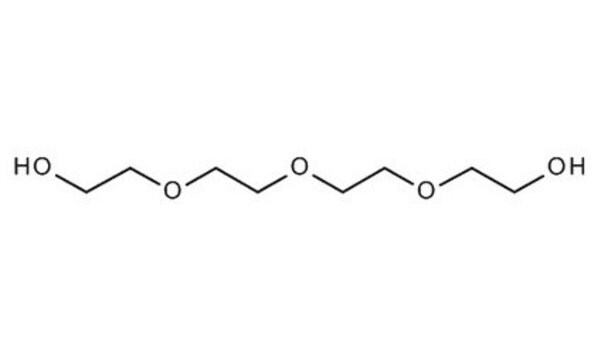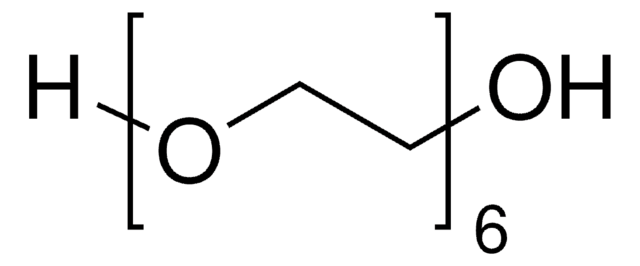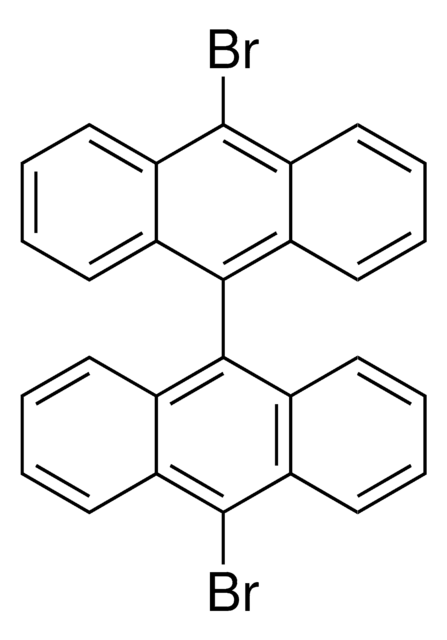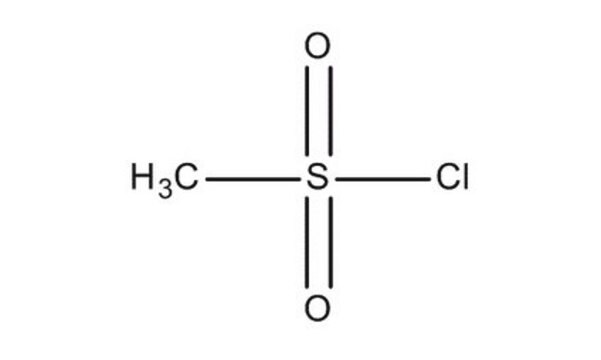8.08245
Triethylene glycol
for synthesis
Synonim(y):
Triethylene glycol, Triglycol
About This Item
Polecane produkty
ciśnienie pary
<0.01 hPa ( 20 °C)
Poziom jakości
Próba
≥99% (GC)
Formularz
liquid
temp. samozapłonu
370 °C
siła działania
17000 mg/kg LD50, oral (Rat)
>5000 mg/kg LD50, skin (Rat)
granice wybuchowości
0.9-9.2 % (v/v)
pH
6.5-7.5 (20 °C, 100 g/L in H2O)
bp
285-295 °C/1013 hPa
mp
-7 °C
temp. przejścia
flash point 165 °C
gęstość
1.123 g/cm3 at 20 °C
temp. przechowywania
2-30°C
InChI
1S/C6H14O4/c7-1-3-9-5-6-10-4-2-8/h7-8H,1-6H2
Klucz InChI
ZIBGPFATKBEMQZ-UHFFFAOYSA-N
Zastosowanie
- Elucidating the Role of Reduction Kinetics in the Phase-Controlled Growth on Preformed Nanocrystal Seeds: A Case Study of Ru: This study explores the phase-controlled growth of ruthenium nanocrystals using triethylene glycol as a reducing agent, providing insights into the kinetics of nanomaterial synthesis for catalytic applications (Nguyen et al., 2024).
- Deep Eutectic Solvents as Agents for Improving the Solubility of Edaravone: Experimental and Theoretical Considerations: This research investigates the use of deep eutectic solvents, including those formulated with triethylene glycol, to enhance the solubility of edaravone. The findings demonstrate significant improvements in drug solubility and bioavailability (Jeliński et al., 2024).
- Probing the evaporation dynamics of semi-volatile organic compounds to reveal the thermodynamics of liquid-liquid phase separated aerosol: This study uses triethylene glycol in experiments to understand the evaporation dynamics and thermodynamics of semi-volatile organic compounds in liquid-liquid phase-separated aerosols. The research provides valuable data for atmospheric chemistry and environmental science (Choczynski et al., 2024).
Komentarz do analizy
Density (d 20 °C/ 4 °C): 1.123 - 1.124
Water (K. F.): ≤ 0.30 %
Identity (IR): passes test
Kod klasy składowania
10 - Combustible liquids
Klasa zagrożenia wodnego (WGK)
WGK 1
Temperatura zapłonu (°F)
330.8 °F - closed cup
Temperatura zapłonu (°C)
166 °C - closed cup
Certyfikaty analizy (CoA)
Poszukaj Certyfikaty analizy (CoA), wpisując numer partii/serii produktów. Numery serii i partii można znaleźć na etykiecie produktu po słowach „seria” lub „partia”.
Masz już ten produkt?
Dokumenty związane z niedawno zakupionymi produktami zostały zamieszczone w Bibliotece dokumentów.
Klienci oglądali również te produkty
Nasz zespół naukowców ma doświadczenie we wszystkich obszarach badań, w tym w naukach przyrodniczych, materiałoznawstwie, syntezie chemicznej, chromatografii, analityce i wielu innych dziedzinach.
Skontaktuj się z zespołem ds. pomocy technicznej










![2-[2-(2-Aminoethoxy)ethoxy]ethanol ≥96.0% (GC)](/deepweb/assets/sigmaaldrich/product/structures/237/185/b94eadd2-5a2c-4a5b-a13d-3d3905df0dbc/640/b94eadd2-5a2c-4a5b-a13d-3d3905df0dbc.png)

